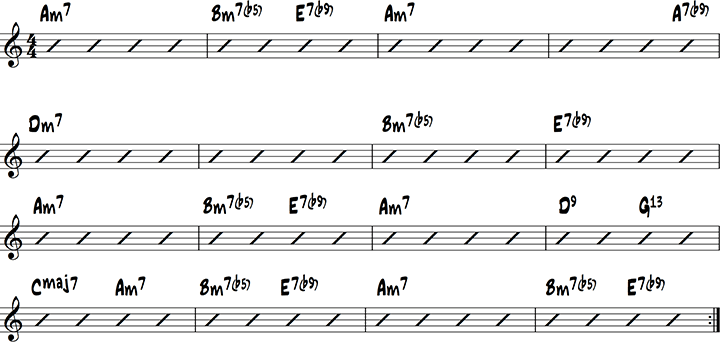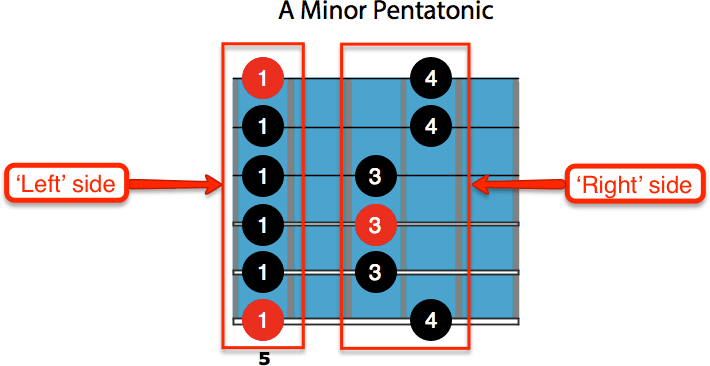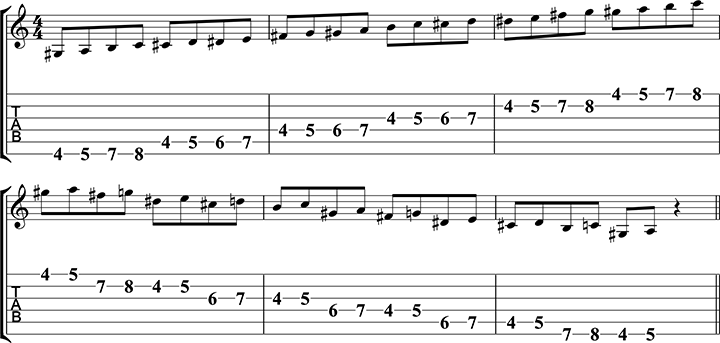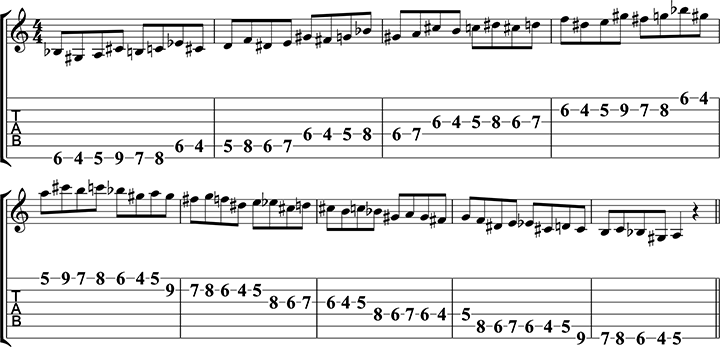Alone Again Naturally Original Guitar Improvisation Music Sheet
Jazz Guitar Improvisation for Beginners: 7 Simple Steps
In this post I demonstrate how like shooting fish in a barrel it is to larn jazz guitar improvisation.
The main reason a lot of people struggle with improvisation on guitar is non that they lack the ability to exercise it, but that they haven't actually nutted out their method for learning it and procedure for practicing it. At that place is zero mystical nigh the ability to improvise – it is a musical skill that anyone serious about music tin can acquire, and should learn, due to the new possibilities that it can open up for yous on your instrument.
Improvisation is fantastic to larn equally:
- It develops your ears to match the audio of the guitar
- Opens up creative possibilities on the instrument
- Gives you lot the ability to jam with other musicians
- Information technology's bully fun to do!
Rather than get too technical into the nuts and bolts of the theoretical concepts about what to do harmonically over the chord changes and then on, this lesson takes a uncomplicated modest pentatonic pattern and improvise with using some standard jazz chord changes.
Handy PDF Download: Become access to a print friendly pdf version of the exercises in this article equally well as a bankroll track to use for your practice session.
How To Learn Jazz Guitar Improvisation
Learning to improvise has similarities with learning a spoken linguistic communication. It is a process of learning vocabulary – however in a musical context the 'words' are actually musical phrases, patterns and ideas.
That's right, you lot demand to actually larn the phrase, patterns and ideas. Improvisation is usually not an act of complete spontaneity, of 'making stuff up on the spot'. Imagine doing that in a speech communication context – people would think you were having some kind of esoteric spiritual experience at best, or at to the lowest degree will not exist able to empathize you at all. This is why to me I think of improvisation more like 'speaking' then creating. Obviously there is inventiveness at play however information technology is primarily a musical way of communicating with your listener and interacting with other musicians.
My 2 year old son is in the process of learning words. Every day he surprises my wife and I with a new i. Notwithstanding when he becomes an adult he'll be able to spontaneously put the words together for the purpose of conversing. The procedure of learning an improvised music course is very like to this.
Learning to Improvise tin can be boiled downwards to a few simple steps:
- Written report the vocabulary. Written report the melodic and harmonic patterns and ideas from guitarists or other musicians that y'all like, and/or ask a teacher for some ideas. For a beginner, the latter is a much faster arroyo (if the teacher is a expert one)
- Implement the vocabulary, and just stick to i idea or lick at a fourth dimension in your do session.
- And then, offset to combine the patterns/ideas/licks you have learned. At this bespeak, your solos will naturally begin to sound much more original.
Ok – so at present you know the procedure, let's now learn a bit of jazz guitar improvisation. In this lesson nosotros'll start out on our improvisation journey with one of the most well known calibration patterns used nearly universally by rock and blues players, the famous minor pentatonic design. As the backing runway is in the fundamental of A Modest, allow's larn this scale on fret 5 to get A minor Pentatonic:

7 Elementary Steps To Sounding Jazzy in Your Improvisation
The lesson video features the following 7 steps to creatively using the pocket-size pentatonic pattern in a jazz guitar improvisation context. Fast forward the video to the time code (in light-green ) to get to the spot in the lesson that demonstrates each step below.
Step ane: Play the minor pentatonic scale pattern over the bankroll runway (ii:58)

Step 1 involves memorising the above pocket-size pentatonic blueprint, and so just messing around a bit with equally yous play the calibration up and downwardly a little bit over the backing track. You lot don't need to play the full scale, just take a few notes here and there and improvise with them using dissimilar rhythms and patterns.
Backing track:

This volition sound ok just won't really sound quite sound 'hip' enough for jazz. To become the jazzy sound we are looking for we are going to use some key ideas from jazz vocabulary. Onwards to step 2:
Step 2: Improvise on the scale in ascending fourths (the 'Left-Upward-Correct-Up' Pattern)(3:50)

A lot of horn players include fourths intervals in their melodic solos, and this is a very convenient interval to play on guitar as the tuning of most of the guitar strings is in fourths. This means to get that jazzy horn sound on guitar you simply need to movement one string beyond as y'all stay on the same fret.
The higher up pattern might expect a bit hard to remember, but in that location is an easy way to navigate this i. Call up of the notes played by the 1st finger as the 'left' side of your mitt, and notes played by fingers 3 & 4 as the 'right' side of the paw:

An easy mode to play this pattern is to recollect 'Left-Up-Correct-Upwardly': every bit you play the calibration cross 'up' to a higher string on the left side of the hand, and then 'up' for the right side of the hand. Play the bankroll track again and use only this idea as you improvise until you feel it really under your fingers.
Step 3: Improvise on the calibration in 'descending' fourths ('Left-Down-Right-Down') (half-dozen:17)

This blueprint is an interesting twist on the previous fourths thought in stride 2. This time, follow each of the scale notes with a note a quaternary below as you arise the calibration. In this example you play 'downwardly' a string on the left side of your paw, and and then 'downward' a string with the correct side.
Once once again, play along with the backing track but just use this 'Left-Down-Right-Downwardly' pattern before you lot move to the adjacent footstep.
Step iv: Ascending followed past descending fourths ('Left-Upward-Correct-Downward') (seven:43)

Still some other variation on fourths patterns on the scale. At present think as if going 'up' ii notes on the left side of the hand, and so 'down' two strings on the right side of the manus, hence the proper noun of this 'Left-Up-Right-Downwards' design.
In one case you have mastered this thought over the bankroll rails, combine all the ideas covered from Stride 1 to iv. You should find that your solo is sounding a bit 'richer' at this point with more than variety.
Step v: Improvise with one-half-step approach notes (9:00)

Half-step approach notes are notes one fret beneath a scale annotation, and are one of the iconic ideas used in jazz. Before you striking each note of the scale simply play a note one fret below each scale note.
Approach notes are fundamental trick to helping your solos sound more jazzy. If you lot solo just with arroyo notes your solo may audio a little bit strange, but it is however of import to initially limit yourself to just using this 1 idea as you exercise over the bankroll track. In one case y'all comprise the other ideas you can apply them more sparingly and it will give a great sound to your solos.
Just as with the previous ideas, do soloing exclusively using one-half-step approach notes for a while over the backing track and then start to combine a solo using the ideas in the previous steps.
Step 6: Contain one-half-stride enclosures (11:09)

The last idea used in this jazz guitar improvisation post is half-step enclosures, a melodic idea used frequently by the bang-up jazz guitarist Joe Pass. Enclosures are notes that environment a scale note. If you play one fret in a higher place a scale note, then one fret beneath, and finally playing the calibration note, you have a one-half-step enclosure. The above practice places enclosures on each step of the scale.
I notice that half-footstep enclosures are quite a 'spicy' solo ingredient, and then in a real solo you would merely use these occasionally. Withal, just as with the previous steps, experiment on the backing runway exclusively using enclosures without other ideas initially. Doing and then will railroad train your ear to their sound so you have more intuition when to include them in your soloing.
Stride 7: Combine all the in a higher place ideas together (13:16)
So y'all have all your ingredients at present, at present information technology's time to combine them into a tasty solo! Deliberately try to incorporate all the above ideas as you practice with the backing rails. Pick perhaps simply 2 of the ideas at a time, and and so finally combine them all equally you improvise.
The magic starts to happen once you have really internalised the vocabulary, and aren't so much consciously thinking nearly using a piece of vocabulary in a solo. Just like when y'all go fluent in a spoken language, you don't demand to think of every single word that you say, you are just spontaneously communicating with someone. This feeling in your solos volition come with time equally you become more than acquainted with the jazz vocabulary.
Handy Resources for Download
To help you to follow forth the process that I've covered in this lesson, I've put together a downloadable pdf that summarises all the scale shapes and variations used in this mail service, so that you can apace become started with this arroyo to jazz guitar improvisation that I've outlined in the article above:
Handy PDF Download: Get admission to a print friendly pdf version of the exercises in this commodity as well as a backing track to apply for your practice session.
In Closing…
I hope that this beginner's guide on jazz guitar improvisation has helped y'all learn this crucial musical skill that is overlooked past many guitarists. Improvisation is a wonderful mode to express yourself in your music and is a great way to develop aural skills too. I am excited to share more than jazz guitar lessons in the future on this blog.
Thank you very much for reading and I promise you had some good takeaways out of this lesson. I would really appreciate your feedback, so practise let me know what yous recall about this post past leaving a annotate below. If you enjoyed this post and would like to be notified when my next posts are coming out, make sure to subscribe to the blog by entering your details below if you oasis't already. I wish you the all-time in your improvisation journeying!
Special thank you to Matt Warnock who originally shared the pentatonic scale ideas with me that were featured in this mail service.
Source: https://www.fretdojo.com/jazz-guitar-improvisation-for-beginners/
0 Response to "Alone Again Naturally Original Guitar Improvisation Music Sheet"
Publicar un comentario